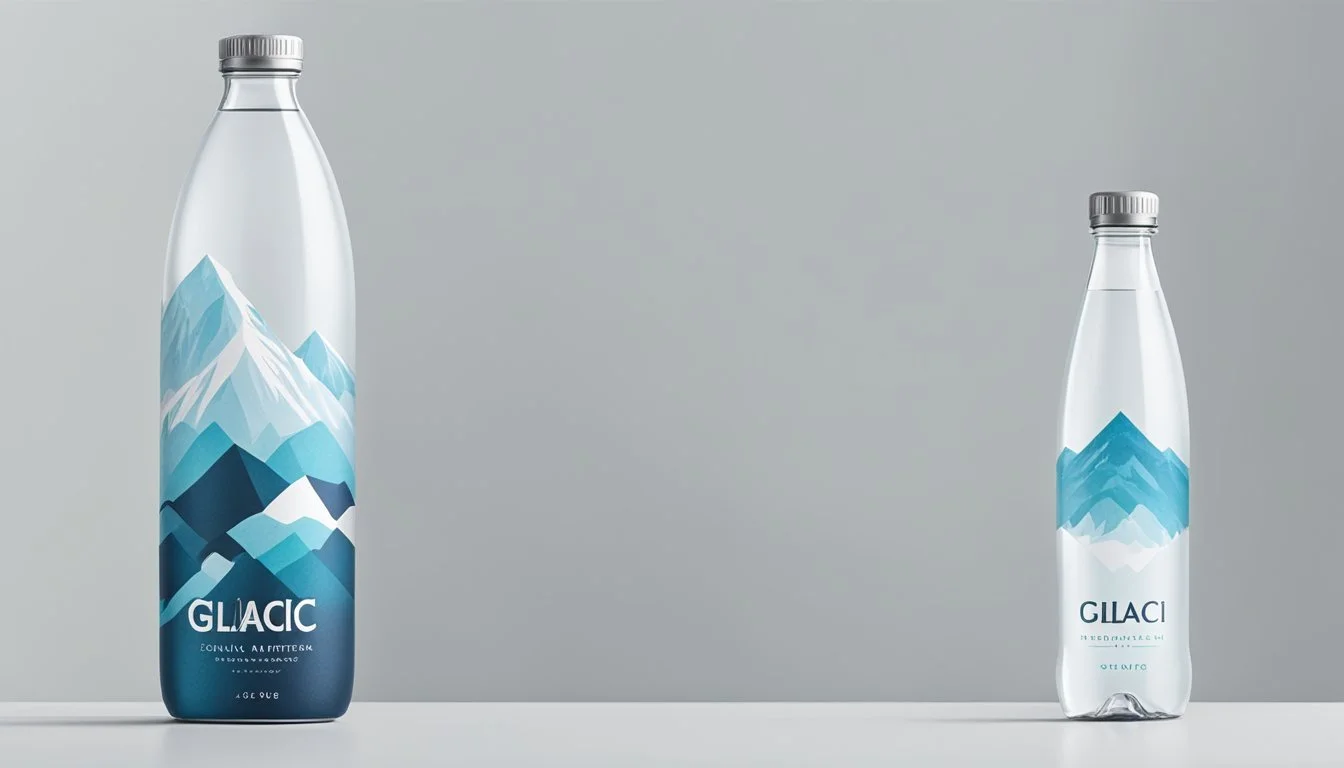Icelandic Glacial vs. The Well
Comparing Premium Bottled Waters
When it comes to choosing between Icelandic Glacial and The Well, discerning water enthusiasts often find themselves at a crossroads. Icelandic Glacial Water stands out for its renowned purity, sourced from the pristine Ölfus Spring in Iceland, offering a refreshing, clean taste respected globally. This brand boasts a balanced mineral content and is marketed as one of the purest bottled waters available.
On the other hand, The Well promises a unique hydration experience, emphasized by its focus on sustainability and eco-friendly packaging. The Well sources its water from naturally protected aquifers, and while it may not have the same level of international acclaim as Icelandic Glacial, it appeals to environmentally conscious consumers seeking more sustainable choices.
Ultimately, the decision between Icelandic Glacial and The Well hinges on personal preference. Both brands provide high-quality hydration options, though with different appeals: Icelandic Glacial for exceptional purity and mineral balance, The Well for its sustainable practices and commitment to protecting natural resources.
Background on Bottled Water
Bottled water has gained popularity as a convenient and sometimes perceived healthier alternative to tap water. Understanding the different types of bottled water and their characteristics can help consumers make informed choices.
Understanding Bottled Water
Bottled water is commonly consumed for its perceived purity, taste, and convenience. It is regulated by various health and safety standards to ensure that it is safe for drinking. Unlike tap water, which is municipally treated, bottled water goes through specific treatments that can include filtration, distillation, and reverse osmosis.
Consumers often choose bottled water based on taste, convenience, and brand reputation. Many bottled water brands highlight their source and mineral content. For instance, Fiji Water is sourced from an aquifer in Fiji and is known for its smooth taste. On the other hand, Smartwater undergoes vapor distillation and adds electrolytes for taste.
Environmental sustainability is a significant concern with bottled water. Companies are increasingly focusing on eco-friendly practices, such as using recyclable materials and reducing carbon footprints.
Types of Bottled Water
There are various types of bottled water, each with unique features. Spring water is sourced from natural springs and is often marketed for its natural purity. Brands like Evian and Poland Spring fall into this category. Mineral water contains naturally occurring minerals and must have no less than 250 parts per million (ppm) of total dissolved solids.
Purified water undergoes extensive treatment processes such as distillation, deionization, or reverse osmosis to remove impurities. Popular brands like Aquafina and Dasani offer purified water. Artesian water is drawn from a well that taps a confined aquifer, such as Voss.
As sustainability becomes crucial, many companies are turning to environmentally friendly options. Brands like Flow and PATH focus on eco-friendly packaging and practices, catering to consumers who prioritize environmental sustainability.
Comparing Icelandic Glacial and The Well
The comparison between Icelandic Glacial and The Well focuses on brand origins, key product factors, and the health and hydration benefits of the two bottled waters.
Brand Origins and Processes
Icelandic Glacial: Icelandic Glacial water is sourced from the Ölfus Spring in Iceland, a large and naturally replenished spring. The spring is renowned for its purity, with water filtered through volcanic rock. The brand boasts being the world’s first CarbonNeutral certified bottled water, reflecting its commitment to sustainable practices.
The Well: The Well sources its water from pristine natural springs and utilizes a thorough filtration process, which includes reverse osmosis. This process ensures the removal of impurities while maintaining essential minerals. The brand focuses on ecological sustainability and adherence to high standards of water quality.
Key Product Factors
Icelandic Glacial:
Source: Ölfus Spring, Iceland.
Filtration: Naturally filtered through volcanic / lava rock.
Mineral Content: Low, with a naturally high pH level of 8.4.
Certification: CarbonNeutral.
The Well:
Source: Multiple natural springs.
Filtration: Includes reverse osmosis.
Mineral Content: Balanced, adjusted for optimal taste and hydration.
Certification: Meets and often exceeds EPA and FDA regulations.
Health and Hydration
Icelandic Glacial: This water has a naturally high pH of 8.4, making it alkaline. Alkaline water is believed to provide several health benefits, including aiding in detoxification, improving hydration, and balancing body pH levels. Its low mineral content and purity also make it suitable for individuals who prefer water with fewer dissolved solids.
The Well: With balanced mineral content, The Well offers benefits for both health and hydration. The minerals retained during the filtration process can aid in electrolyte balance, essential for proper bodily functions. The implementation of reverse osmosis ensures high safety and cleanliness, making The Well a reliable choice for those concerned with water purity and health standards.
Taste and Mineral Content
The taste and mineral content of bottled water can vary significantly between brands. Icelandic Glacial and The Well offer distinct differences in flavor profiles and mineral benefits, influenced by their unique sources and natural filtration processes.
Flavor Profiles
Icelandic Glacial water originates from the Olfusa spring in Iceland. Its flavor is described as crisp and clean, with a slightly sweet note due to its low mineral content. The water's natural filtration through volcanic rock results in a smooth taste that many consumers find refreshing.
The Well sources its water from carefully selected springs and aquifers. The mineral composition gives it a more pronounced taste compared to Icelandic Glacial. The Well often has a mildly earthy flavor, influenced by higher levels of calcium and magnesium, providing a robust and satisfying drinking experience.
Benefits of Minerals in Water
Calcium: Both brands contain calcium, essential for bone health. Icelandic Glacial has moderate calcium levels, contributing to its smooth taste. The Well has higher calcium content, benefiting those seeking mineral-rich hydration.
Magnesium: Magnesium is crucial for muscle and nerve function. The Well's water, with its higher magnesium levels, is particularly effective in supporting these bodily functions. Icelandic Glacial offers a balanced amount, maintaining a light and refreshing taste.
Potassium: Important for heart health, potassium is present in both waters. The Well’s higher potassium content aids in maintaining proper heart and muscle function, while Icelandic Glacial provides a balanced intake.
Sodium and Bicarbonate: The Well contains moderate levels of sodium and bicarbonate, enhancing its alkalinity and making it a good option for those looking to balance their body's pH levels. Icelandic Glacial’s lower sodium content makes it a preferable choice for those monitoring their sodium intake.
Alkaline pH Level: Icelandic Glacial boasts a naturally high pH level of 8.4 due to its filtration through volcanic rock, making it one of the more alkaline spring waters. This higher alkalinity can help neutralize acid in the body. The Well's pH varies but is also generally alkaline, supporting overall well-being.
Both waters offer unique benefits, making them excellent choices depending on the consumer’s preferences and health needs.
Sustainability and Environmental Impact
Both Icelandic Glacial and The Well prioritize sustainability and aim to lessen their environmental impact through various practices, from bottling to recycling.
Environmental Commitments of Brands
Icelandic Glacial sources its water from the Ölfus Spring in Iceland, renowned for its purity and natural filtration. It boasts a carbon-neutral certification, reflecting efforts to offset CO2 emissions. This brand commits to protecting its source through eco-friendly practices, ensuring that the spring remains untouched and sustainably managed.
The Well also emphasizes environmental sustainability. The brand often highlights its commitment to sourcing water responsibly and reducing its carbon footprint. It aims to minimize pollution through stringent regulation of its bottling operations and shipping processes, striving for a balance between business operation and environmental care.
Packaging and Recycling
Icelandic Glacial uses predominantly BPA-free plastic and recyclable materials for its bottles. They have implemented efficient recycling programs and continuously seek ways to lessen their environmental impact through innovative packaging solutions. The brand’s use of glass bottles for some of its products further emphasizes a commitment to reducing plastic waste.
The Well similarly adopts eco-friendly packaging strategies. The firm promotes the use of recyclable PET plastic and has invested in programs aimed at enhancing the efficiency of recycling these materials. Additionally, The Well often explores alternatives such as biodegradable and reusable packaging, aiming to contribute positively to reducing global pollution.
Comparative Analysis of Purity and Safety
When comparing Icelandic Glacial and The Well bottled water, it is essential to analyze their purity and safety standards. This involves examining their filtration processes, safety measures against contaminants, and overall adherence to regulatory standards.
Filtration and Purity Standards
Icelandic Glacial originates from the Ölfus Spring in Iceland. The water is naturally filtered through volcanic rock, providing a high level of purity. This natural filtration process helps to reduce impurities and maintain a balanced mineral content.
The Well sources its water from artesian wells, utilizing advanced filtration systems to remove impurities. Techniques include reverse osmosis and UV light treatment, designed to exceed stringent purity standards. These filtration methods ensure the removal of heavy metals and other contaminants, resulting in remarkably clean water.
Total Dissolved Solids (TDS), which indicates the presence of dissolved substances, are low in both brands. Icelandic Glacial reports TDS levels of approximately 62 parts per million (ppm), reflecting high purity. The Well also competes with similarly low TDS levels, indicative of comprehensive filtration practices.
Safety and Contaminant Levels
Icelandic Glacial adheres strictly to international safety standards. Regular quality reports and certifications confirm the absence of harmful substances. The water is free from microplastics and other potential contaminants. The low levels of nitrates and heavy metals further underscore its safety.
The Well emphasizes safety in its production process. Continuous testing ensures compliance with FDA regulations and other safety guidelines. The water undergoes rigorous filtration to eliminate contaminants, including fluoride and heavy metals. Quality reports often highlight the effectiveness of these measures.
Electrolyte Balance is another aspect where both brands perform well. Icelandic Glacial’s volcanic filtration ensures naturally occurring electrolytes such as calcium and magnesium. The Well’s advanced purification techniques also retain essential electrolytes, promoting healthier hydration.
Certification and Standards: Both brands boast multiple certifications affirming their commitment to purity and safety. Adherence to international standards like those set by the FDA and NSF strengthens consumer confidence in their product quality.
This detailed comparison provides insights into the filtration and safety measures that distinguish these bottled water brands, highlighting the rigorous processes that ensure high-quality water.
Packaging Materials and Convenience
Packaging and consumer convenience play critical roles in distinguishing bottled water brands. Icelandic Glacial and The Well prioritize these aspects to meet environmental and user-friendly standards.
Types of Packaging
Icelandic Glacial uses PET bottles made from BPA-free plastic, ensuring the packaging remains safe and recyclable. Their innovative labeling is minimal, reducing waste.
The Well also opts for eco-friendly materials, focusing on both glass and rPET (recycled PET) bottles. The glass option caters to premium consumers seeking a plastic-free experience, while the rPET bottles are designed to minimize the carbon footprint by using recycled materials.
Comparison:
Icelandic Glacial: BPA-free PET plastic, minimal labels
The Well: Glass, recycled PET (rPET) plastic
Environmental Impact:
Icelandic Glacial: Recyclable but plastic-based
The Well: Glass is highly recyclable; rPET reduces plastic waste
Convenience for Consumers
Icelandic Glacial offers lightweight bottles that are easy to carry and store. The design fits well into most standard cup holders and refrigerators, making it convenient for on-the-go hydration.
The Well provides options that cater to both portability and at-home use. Their glass bottles, though heavier, offer a premium feel and are often reusable. The rPET bottles are lighter, easy to cap and reseal, enhancing portability.
Comparison:
Icelandic Glacial: Light, portable, easy to store
The Well: Glass for at-home use, rPET for on-the-go
User Experience:
Icelandic Glacial: Practical for active lifestyles
The Well: Versatile, from premium home use to convenient travel options
The Verdict
Icelandic Glacial and The Well offer unique attributes that set them apart in taste, purity, and environmental impact.
Critical Evaluation
Taste: Icelandic Glacial is often praised for its crisp, refreshing taste, derived from Iceland’s natural springs. On the contrary, The Well has a milder and softer taste, appealing to those who prefer less mineralized bottled water.
Purity: Icelandic Glacial boasts of high purity levels and balanced mineral content, including calcium, magnesium, and potassium. The Well, while still pure, does not highlight such a specific mineral profile, focusing instead on minimal processing.
pH Balance: Icelandic Glacial has an alkaline pH level, which some consumers believe enhances hydration. The Well maintains a neutral pH aimed at balanced hydration without altering the body's pH level significantly.
Sustainability: Icelandic Glacial emphasizes its environmentally friendly practices, with a focus on using fully recyclable packaging and minimal carbon footprint during production. The Well also prioritizes sustainability but lacks as prominent a publicized effort compared to Icelandic Glacial.
Bottom Line for Consumers
Consumers looking for a premium taste and alkaline pH level might favor Icelandic Glacial, known for its crisp and refreshing profile. Its balanced mineral content also adds to its appeal.
Health implications should be considered. Icelandic Glacial's specific mineral content supports various health benefits, making it suitable for those needing these minerals. The Well provides purified water that is less focused on mineral contributions.
Regarding environmental impact, Icelandic Glacial makes a compelling choice with its robust sustainability initiatives. For eco-conscious consumers, Icelandic Glacial’s fully recyclable packaging and reduced carbon footprint may be decisive factors.
Consumers should also consider personal preference in terms of taste and day-to-day hydration needs, as each brand brings distinct benefits to the table.
More About Icelandic Glacial
Acqua Panna vs Icelandic Glacial: Which Bottled Water is Better?
Aquafina vs Icelandic Glacial: Which Bottled Water is Better?
Arrowhead vs Icelandic Glacial: Which Bottled Water is Better?
Boxed Water vs Icelandic Glacial: Which Bottled Water is Better?
Core Hydration vs Icelandic Glacial: Which Bottled Water is Better?
Deer Park vs Icelandic Glacial: Which Bottled Water is Better?
Essentia vs Icelandic Glacial: Which Bottled Water is Better?
Eternal vs Icelandic Glacial: Which Bottled Water is Better?
Ice Mountain vs Icelandic Glacial: Which Bottled Water is Better?
Icelandic Glacial vs 1907water: Which Bottled Water is Better?
Icelandic Glacial vs 7-Select: Which Bottled Water is Better?
Icelandic Glacial vs Alkaline88: Which Bottled Water is Better?
Icelandic Glacial vs Antipodes: Which Bottled Water is Better?
Icelandic Glacial vs Aqua Carpatica: Which Bottled Water is Better?
Icelandic Glacial vs Big Chill: Which Bottled Water is Better?
Icelandic Glacial vs Big Win: Which Bottled Water is Better?
Icelandic Glacial vs BodyArmor: Which Bottled Water is Better?
Icelandic Glacial vs Cascade Mountain: Which Bottled Water is Better?
Icelandic Glacial vs Castle Rock: Which Bottled Water is Better?
Icelandic Glacial vs CBD Living: Which Bottled Water is Better?
Icelandic Glacial vs Crystal Geyser: Which Bottled Water is Better?
Icelandic Glacial vs Crystal Lake: Which Bottled Water is Better?
Icelandic Glacial vs Erewhon: Which Bottled Water is Better?
Icelandic Glacial vs Essence pH10: Which Bottled Water is Better?
Icelandic Glacial vs Hawaii Volcanic: Which Bottled Water is Better?
Icelandic Glacial vs Hawaiian Springs: Which Bottled Water is Better?
Icelandic Glacial vs Just Water: Which Bottled Water is Better?
Icelandic Glacial vs Kirkland Signature: Which Bottled Water is Better?
Icelandic Glacial vs LIFEWTR: Which Bottled Water is Better?
Icelandic Glacial vs Liquid Death: Which Bottled Water is Better?
Icelandic Glacial vs Mananalu: Which Bottled Water is Better?
Icelandic Glacial vs Mountain Valley Spring Water: Which Bottled Water is Better?
Icelandic Glacial vs Nestle Pure Life: Which Bottled Water is Better?
Icelandic Glacial vs Open Water: Which Bottled Water is Better?
Icelandic Glacial vs Perrier: Which Bottled Water is Better?
Icelandic Glacial vs Poland Spring: Which Bottled Water is Better?
Icelandic Glacial vs Proud Source: Which Bottled Water is Better?
Icelandic Glacial vs Pure Life: Which Bottled Water is Better?
Icelandic Glacial vs Purely Sedona: Which Bottled Water is Better?
Icelandic Glacial vs Refreshe: Which Bottled Water is Better?
Icelandic Glacial vs Richard's Rainwater: Which Bottled Water is Better?
Icelandic Glacial vs San Pellegrino: Which Bottled Water is Better?
Icelandic Glacial vs Simple Truth: Which Bottled Water is Better?
Icelandic Glacial vs Smartwater: Which Bottled Water is Better?
Icelandic Glacial vs Solan de Cabras: Which Bottled Water is Better?
Icelandic Glacial vs Starkey: Which Bottled Water is Better?
Icelandic Glacial vs Talking Rain AQA: Which Bottled Water is Better?
Icelandic Glacial vs Topo Chico: Which Bottled Water is Better?
Icelandic Glacial vs Tru Alka: Which Bottled Water is Better?
Icelandic Glacial vs Waiakea: Which Bottled Water is Better?
Icelandic Glacial vs Weird Water: Which Bottled Water is Better?
Icelandic Glacial vs Whole Foods 365: Which Bottled Water is Better?
Icelandic Glacial vs Whole Foods Italian Still Mineral water: Which Bottled Water is Better?
Icelandic Glacial vs Zephyrhills: Which Bottled Water is Better?
Icelandic Glacial vs HFactor: Which Bottled Water is Better?
More About The Well
Cascade Mountain vs The Well: Which Bottled Water is Better?
Hawaiian Springs vs The Well: Which Bottled Water is Better?
Mountain Valley Spring Water vs The Well: Which Bottled Water is Better?
Nestle Pure Life vs The Well: Which Bottled Water is Better?
Richard's Rainwater vs The Well: Which Bottled Water is Better?
The Well vs Kirkland Signature: Which Bottled Water is Better?
The Well vs Talking Rain AQA: Which Bottled Water is Better?
Whole Foods Italian Still Mineral water vs The Well: Which Bottled Water is Better?





